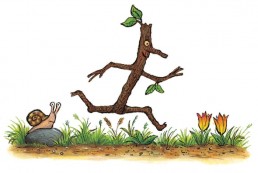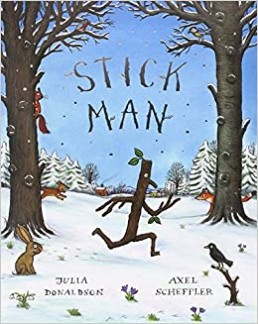Home School Activity 3- Make Your Own Stick Man
Implementation
Resources: Sticks
Use the different sized sticks you’ve collected to make a Stick Man.
How will you join them together?
What could you use for his eyes?
Take a photograph of your Stick Man and share it with us!
Intent- Learning Objectives
Moving and Handling
22-36 months
- Shows control in holding and using jugs to pour, hammers, books and mark-making tools.
- Beginning to use three fingers
30-50 months
- Uses one-handed tools and equipment
40-60 months
- Uses simple tools to effect changes to materials.• Handles tools, objects, construction and malleable materials safely and with increasing control.
Literacy
22-36 months
- Has some favourite stories, rhymes, songs, poems or jingles
30-50 months
- Describes main story settings, events and principal characters.• Shows interest in illustrations and print in books and print in the environment.
40-60 months
- Uses vocabulary and forms of speech that are increasingly influenced by their experiences of books.• Enjoys an increasing range of books.
Being Imaginative
22-36 months
- Beginning to use representation to communicate, e.g. drawing a line and saying ‘That’s me.’
30-50 months
- Captures experiences and responses with a range of media, such as music, dance and paint and other materials or words.
40-60 months
- Creates simple representations of events, people and objects.
Exploring and using media and materials
30-50 months
- Joins construction pieces together to build and balance.• Realises tools can be used for a purpose.
40-60 months
- Understands that different media can be combined to create new effects. • Manipulates materials to achieve a planned effect.• Constructs with a purpose in mind, using a variety of resources.• Uses simple tools and techniques competently and appropriately.• Selects appropriate resources and adapts work where necessary.• Selects tools and techniques needed to shape, assemble andjoin materials they are using.
Technology
30-50 months
- Knows how to operate simple equipment, e.g. turns on CD player and uses remote control
Impact-
How did this activity go? Please use this space to record any findings, adaptions, reflections and quotes from your children. We would love you to email them back to us or share them on Tapestry, Instagram or Facebook.
Story Time- Open ended Question ideas
This applies to all books you may be reading with your children, not just stickman.
Looking at the Cover
Can you find the Front Cover?
What can you see on the front cover?
What might this book be about?
Can you find/point to the title?
What might happen in the story?
Parent can read the title and ask again what might happen.
Talk about the Author/Illustrator and any related books
Inside the Book
What is happening on this page?
Can you turn the next page?
How do you think the character feels? Why?
How would you feel?
What might happen next?
Do you know what that word means?
What might happen at the end of the story?
When Finished
Can you remember the characters in the story?
What happened in the story?
What happened to this character in the story?
What did you find out?
Did you like this book…why?
What was your favourite part?
Who was your favourite character?
Can you re-tell the story in your own words?
Do you like how the story ended?
Can you think of another way the story could have ended?
We suggest your child listens to the story with you many times over a week and is able to look at the book/video independently when chooses to. Your child will become familiar with the story, characters, depth of the story messages, rhyme and phrases, illustrations and even letter/word recognition. Hopefully they will be able to retell the story, talk in more detail about the characters and their feelings/actions, use their imagination to change parts of the story or rhyme, draw simple representations of the characters or main events, role play the story, copy words/label pictures from the story or share retelling with younger siblings.
https://www.youtube.com/watch?v=6FlKIjVeNY0&t=18s
Home School Activity 2: Sticks
Resources: Sticks
Implementation
We see a lot of you found sticks during your scavenger hunt, so using these sticks, encourage your children to look at the sizes of them and ask what they can see.
 Support them if necessary to place the sticks into size order using mathematical language of size and length, long, short, biggest, smallest, medium etc.
Support them if necessary to place the sticks into size order using mathematical language of size and length, long, short, biggest, smallest, medium etc.
Extension – using a stone, hands, Lego or what your child believes would be appropriate, (trial and error and problem solving) you could measure the sticks and record your findings with any representation suitable with your child’s ability, such as drawing pictures, taking photographs, writing digits.
Intent- Learning Objectives-
Here's what your children will get out of this activity, within their age brackets.
Maths- Shape, Space and Measure
22-36 months
- Beginning to categorise objects according to properties such as shape or size.
- Begins to use the language of size
30-50months
- Uses positional language.
40-60 months
- Orders two or three items by length or height
PSED – Personal, Social, Emotional Development
30-50 months
- Can select and use activities and resources with help.
- Welcomes and values praise for what they have done.
- Enjoys responsibility of carrying out small tasks.
- Shows confidence in asking adults for help.
40-60 months
- Confident to speak to others about own needs, wants, interests and opinions.
- Can describe self in positive terms and talk about abilities.
Impact- Please use this space (or a sheet of paper) to record any findings, adaptions, reflections and quotes from your children. We would love you to email them back to us or share them on Tapestry.
Happy Measuring.
The VIN Team (Virtual Inspirations Nursery)
Reggio Emilia At Home
Dear Parents, this is the first of many posts aimed to help those of you who are at home with your children. We will be providing daily activities for you to do with your children at home, and we would love to hear back from you every step of the way. Keep checking our Facebook posts and our Instagram stories for updates and share your findings on tapestry.
Overview of Reggio Emilia
One type of learning that many parents have adapted for use in the home-school setting is the Reggio Emilia approach. The Reggio Emilia approach to early childhood is a long used and well-respected technique used by educators and parents around the world. Reggio Emilia is a method, which requires no special training, just an understanding of basic principles.
In a nutshell, there are a few ideals that guide Reggio classrooms, and these can be easily transferred into the home setting. This philosophy was first developed in the 1960’s in Reggio Emilia, Italy, as a means to create an atmosphere to truly develop children’s intelligence and desire to learn. In this approach children were seen as highly capable, curious leaners, who are capable of constructing their own learning.
Reggio Materials
Open-ended items from nature play an important role in the Reggio inspired classroom. Pinecones, stones, shells, sticks, bark and leaves can be used for many purposes. Children can create from them, examine them, and use them to represent concepts. To have a large amount of stones for example will encourage maths, counting, making shapes, building, imagination and communication. The use of loose parts will keep your children occupied, investigating and using their imagination and problem solving ideas.

Other open-ended types of materials may include a collection of wooden blocks, scraps of fabric, a basket of scarves, ceramic tiles or mosaic glass pieces, cardboard tubes, or any other type of material that children may be interested in. You may be very interested to watch what children will create with everyday items
Activity One
Scavenger Hunt- One of the first things you could do with your children is to go on a resources hunt in the garden, attic or garage for any of the items above. We look forward to seeing your findings on tapestry, and remember almost anything can be classed as a loose part.
Principles of Reggio Emilia
This approach works on a few guiding principles, and parents who are seeking to implement a Reggio inspired home-school can use these as a guideline for their ‘classroom’.
- The child should have some control over their own learning. They should be allowed to develop and follow their own interests.
- Learning is best acquired through a multi sensory approach. Touching, listening, seeing, hearing and moving allow children to thoroughly understand.
- Teachers/parents are mentors and guides, but not the keepers of all knowledge. They should work alongside the children to ensure true understanding, but keep in mind that the learning process should be primarily child led.
- The environment is seen as the ‘third teacher’. Materials are carefully selected and rooms are free of clutter. Natural light, order and beauty are hallmarks of a Reggio classroom.
- Project based learning is encouraged. Instead of isolating subject areas, students are encouraged to truly research their interests from many angles. Whatever they choose to learn about can be read about, written about, painted, built etc.
- Documentation is paramount. One highlight of the Reggio approach is the importance it places of documentation. Examples of student work are highly visible. Teachers record children’s thoughts and conversations to then showcase them to make their thinking visible.
- Communication is imperative. In the Reggio approach, children are talked with, listened to, and respected. They are encouraged to use language to explore, and in the early years, sounds rhyme and rhythm are toyed with. Later, rich conversations drive much of a child’s learning.
- The One Hundred Languages of Children: One of the most important ideals driving the Reggio Emilia philosophy is referred to as the Hundred Languages of Learning. This means that children have many different ways to express their thoughts and learning. Hands- on learning and play are ways that children can demonstrate their learning, along with song, dance, drawing, writing, painting, physical activity, pretend play and story telling, just to name a few. Each of these activities are seen as valid methods of learning about the world and work together to compose an entire child.
Mirrors
 One hallmark to the Reggio approach is the use of mirrors throughout the play/work area. Mirrors are used not only on the walls, but also on surfaces to provide another point of view and depth of understanding. Children who are building with blocks can see their structure from a new perspective when a mirror is placed next to it. Children working with stones can see it from all angles when working on a mirrored surface. Using mirrors adds a new depth to children’s inquiry. When selecting mirrors for your home-school, you should keep the child’s age in mind. Very young children may need to use acrylic mirrors as a safety precaution as they may lean on them during their play, causing breakage.
One hallmark to the Reggio approach is the use of mirrors throughout the play/work area. Mirrors are used not only on the walls, but also on surfaces to provide another point of view and depth of understanding. Children who are building with blocks can see their structure from a new perspective when a mirror is placed next to it. Children working with stones can see it from all angles when working on a mirrored surface. Using mirrors adds a new depth to children’s inquiry. When selecting mirrors for your home-school, you should keep the child’s age in mind. Very young children may need to use acrylic mirrors as a safety precaution as they may lean on them during their play, causing breakage.
Inquiry Based learning
One of the best ways to determine ideas for study is by listening to the questions your children ask, or observing them while they are playing. Perhaps they said “It is so cool that water turns into the shape of my bucket when I pour it”, or “why don’t you ever see bats in the daytime?”. These simple conversations can lead to some of the best lessons you can do with your child. Stock your work area up with books about matter or nocturnal animals. Follow your child’s lead.
Once you have stumbled upon a topic that seems to grab your child’s attention, look for ways for them to explore it. Provide them with materials that can deepen their understanding and allow them to express themselves in one of the one hundred ways.
 The number one most important thing a home-school parent needs to remember is to follow the child. If they are not interested, they will not be engaged and very little true learning will occur. Often time, parents will see an activity that they think looks interesting or a book that they find beautiful only to be disappointed in their child’s lack of curiosity in the topic.
The number one most important thing a home-school parent needs to remember is to follow the child. If they are not interested, they will not be engaged and very little true learning will occur. Often time, parents will see an activity that they think looks interesting or a book that they find beautiful only to be disappointed in their child’s lack of curiosity in the topic.
Reggio Emilia is one great philosophy to adapt to a home-school setting. It is not expensive to implement, requires no specialised training, and is very flexible. Remembering a few simple principles will allow you to follow the lead of your child, and maximise their academic potential as well as foster a curious nature and a love of learning.
The Inspirations Home School Team



